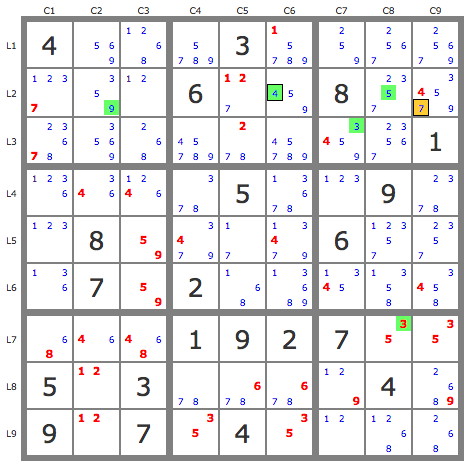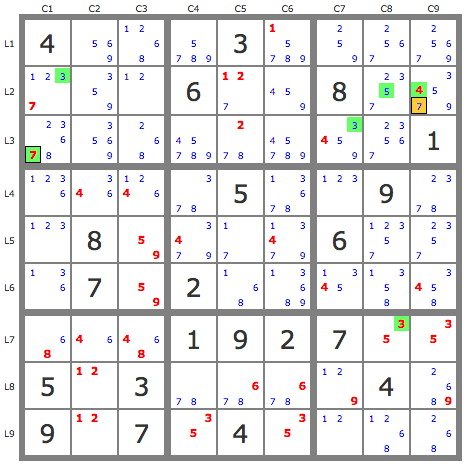The difficulties I have in understanding the theories of your book PBCS are linked to my very bad English on the one hand, but also to the mass of concepts and definitions that need to be assimilated. Probably also to my limits in abstract mathematics.
In order to advance in the understanding of the whips that I am particularly interested in sudoku, I would like you to tell me if the following interpretation of the definition of a whip is correct.
A whip is a chain of candidates (Ao, A1, ... An) attached to a target Z linked to Ao, which is constructed by considering as elements of the chain the candidates Ai linked to each other and compatible with Z. A candidate is compatible with Z as long as it does not see Z and does not see a candidate that sees Z.
If I take the example of this puzzle detailed in your Subsets in SudoRules
4...3.......6..8..........1....5..9..8....6...7.2........1.27..5.3....4.9........
At the next whip stage
whip [6]: r2n4{c9 c6} - r2n9{c6 c2} - r2n5{c2 c8} - r7c8{n5 n3} - b3n3{r3c8 r3c7} - r3n4{c7 .} ==> r2c9 ≠ 7
My interpretation is as follows:
-4r2c9->4r2c6->-9r2c6->9r2c2(9r2c9 not compatible)->-5r2c2->5r2c8(5r2c9 not compatible)->-5r7c8->3r7c8->-3r3c8->3r3c7->-4r3c7 contradiction => r2c9 ≠ 7 (see puzzle1)
puzzle1: Show
This interpretation of a whip, correct or not, led me to establish (extremely easy demonstration) an interesting result in the practice of the TDP methods that I give you here.
Ao, A1, ... An being candidates who see a Z target,
If the cascade of anti-tracks P'(Ao).P'(A1).P'(A2). . . .P'(An) results in a contradiction, or contains a candidate B who sees Z, then Z may be eliminated.
In the above example, Ao=4r2c9, A1=9r2c9 and A2=5r2c9 and the described string is written P'(Ao).P'(A1).P'(A2) (see puzzle1)
On the same puzzle, we can eliminate 7r2c9 with the cascade P'(7r2c1).P'(7r2c5).P'(7r2c8) which contains 4r2c9 (see puzzle2)
puzzle2: Show
Sincerely
Robert



